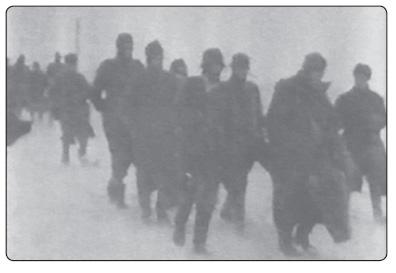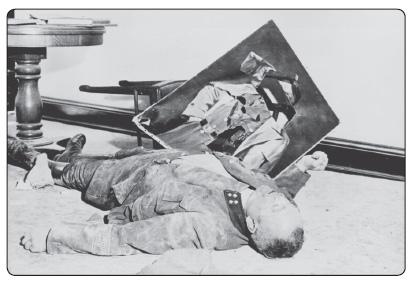The History Buff's Guide to World War II (20 page)
Read The History Buff's Guide to World War II Online
Authors: Thomas R. Flagel

Surviving wounds for any soldier depended heavily on how quickly he could be evacuated.
Nearly all armed forces gave ribbons or medals to soldiers wounded in combat. The U.S. Purple Heart originated during the American Revolution, where it was initially given as a recognition of valor.
5
. DISEASE (1.5 MILLION)
Many soldiers never saw combat, but all were vulnerable to illness. High stress, tight quarters, diet fluctuations, and reduced sleep all contributed to high disease rates. For every U.S. soldier overseas, his chances of getting wounded were 7 percent, injured 11 percent, and sick 70 percent.
62
Primary causes were contaminated food and water, which invited the perennial guests of wartime: dysentery, diarrhea, cholera, and typhoid. Gnawing lice injected their hosts with typhus, a chief killer everywhere. Pneumonia claimed untold numbers, brought on by damp living conditions and exhaustion.
Swarming in the Mediterranean and tropical regions were mosquitoes, which the Japanese called “the Great Enemy.” Various breeds injected several forms of malaria, including cerebral malaria, which produced brain-baking fevers of 110°F. Entire regiments were left prostrate with symptoms similar to severe food poisoning.
In the petri dish of Southeast Asia were skin diseases, including deadly jungle rot. Entering through any break of the skin, an intense bacterium gradually ate away at the flesh, producing golf ball–sized holes in the body. Unless treated with antibiotics, amputation, or aggressive scraping, death was probable.
63
Along with the above killers, soldiers also succumbed in large numbers to diphtheria, beriberi, tetanus, meningitis, influenza, tuberculosis, and scarlet fever. The Japanese idiom made a strong case when it contended, “To fall in a hail of bullets is to meet a hero’s death, but there is no glory in dying of disease.”
64
Survival depended on rest, nutrition, and the correct medication, luxuries commonly available to American and British soldiers but less so among Germans and Russians. Hardest hit were Chinese, Japanese, and colonial troops, who suffered terribly from inadequate supply systems, lack of reinforcements, and poor medical support. In cases of malaria, Japanese soldiers died ten times more often than Americans.
Testament to the variety and severity of illnesses in Southeast Asia during the war, among the diseases reported in the region were leprosy and the bubonic plague.
6
. ACCIDENT (1.4 MILLION)
From the minute they put on a uniform, officers and enlisted were in danger. Combat training produced a high rate of injuries and sometimes death, especially when live ammunition was used during instructional exercises. Weapons testing was often as perilous as frontline duty. Logistical support was particularly dangerous, as it involved heavy equipment transporting huge amounts of fuel and ammunition over distances of thousands of miles.
65
In July 1944, while U.S. sailors were loading tons of ammunition into ships docked near San Francisco, an explosion detonated the entire cargo and instantly killed more than three hundred men.
Sailing in rough waters was extremely hazardous, more so when ice and wind were involved, taking an untold number of men overboard. U.S. Adm. John W. Wilcox was one of the highest-ranking Americans killed in the war when he was swept from his ship and into the Atlantic in March 1942.
66
In air operations, collisions, human error, and mechanical or electrical failure tended to have extreme consequences. The Finnish air force lost over half its planes in operations other than combat. The Luftwaffe estimated to have lost 70,000 airmen killed in action and a quarter-million dead in accident-related events. In all, 35,946 American aviators died in accidents, or 43 percent of all accidental deaths of U.S. armed forces. Losses were so high in routine stateside flights that Florida crews coined the phrase, “One a day in Tampa Bay.”
67
Though technically killed in action, victims of friendly fire numbered in the hundreds of thousands. Working in tandem with infantry movements, artillery and bombing runs sometimes fell short, with disastrous effects. Allied soldiers advancing on Caen in Normandy were torn apart by Allied bombs intended for the German-held city. To keep warm on the eastern front, Germans wore toasty felt hats captured from the Russians and were summarily mistaken for the enemy and fired upon. Poor communication and low visibility made any fire fight a chance for unintentional fratricide.
Aerial accidents and malfunctions cost the lives of Heisman Trophy winner Nile Kinnick, John F. Kennedy’s brother Joseph, and more than a dozen American generals.
7
. EXPOSURE (1 MILLION)
During the war, military operations occurred in a range of nearly two hundred degrees. In the “sun’s anvil” of North Africa, heat indexes in unventilated tanks broiled to 140°F and higher. The merciless winters of northern Russia brought long periods of –40° and colder.
Ironically, soldiers dying from heat or cold experienced similar ends. First came a brief period of intense pain, which gave way to a numbing state of shock and mental delirium. The victim them slipped into a coma, commonly a point of no return. One by one, organs shut down, ending with heart failure. Of the extremes, cold claimed more lives. Ground troops in Europe experienced frostbite as far south as the mountains near Naples. Sailors swept into the North Atlantic froze long before they drowned. Wounded soldiers on both sides of the eastern front were often evacuated via unheated trucks and railcars. Many casualties arrived at their destinations frozen solid.
Though death by exposure occurred year-round, desert storms and winter blizzards often brought spikes in the toll. Troops caught away from shelter had slim chances of survival. Footpaths and roads disappeared under drifts; trenches filled in an instant. Landmarks, rare in barren areas, became invisible. Soldiers struggling to find shelter sometimes made the fatal mistake of stepping a few feet in the wrong direction, headed off into nothingness, and died slowly from dehydration or frost.
68

Captured Germans suffer through a blast of Russian winter winds. Hunger and illness increased a soldier’s chances of dying from the elements.
Allied bombing raids from North Africa to the Balkans were particularly difficult on the body. Crew members often suited up in 100°F heat, only to fly into the mountainous region at twenty thousand feet, where the air temperature fell to –50°F.
8
. STARVATION (800,000)
Although many units underwent periods of shortage, some were emaciated too often and too intensely to ward off fatalities from starvation. In some instances, soldiers witnessed friends turn into something like pack animals, killing civilians, enemies, and each other for pieces of bread.
69
As always, exact numbers of dead are unknown. Situations decrepit enough to cause famine were normally not conducive to record keeping. Also, acute hunger made victims extremely susceptible to fatal diseases.
Prison camps were the site of most military deaths by starvation, particularly between Berlin and Moscow. Also dangerous was any besieged area. German corpses at Stalingrad showed clear signs of famine—distended abdomens, gaunt faces, complete absence of subcutaneous fat—but doctors were forbidden to report starvation as a cause of death. The fight for Guadalcanal, into which Japan fed thirty thousand troops piecemeal, became a supply nightmare. Unable to hold on to ports, pushed to the least accessible corners of the mountainous areas, already undersupplied by Tokyo, the garrisons lost more men from hunger than from American bullets. One Imperial officer wrote in his diary: “Rice. I really want rice…Even when mortars are falling like a squall or the land is reshaped by bombs I don’t worry. But I can’t stand looking at my men become pale and thin.” In several areas and in several instances, soldiers resorted to suicide or cannibalism rather than face hunger any longer.
70
One German soldier recalled seeing a group of wounded Soviet prisoners on the eastern front. All were begging for food, including several who were wounded in the abdomen, with strands of intestine hanging out.
9
. EXECUTION (700,000)
In April 1943 the German army came upon forty-four hundred corpses hastily buried in the Polish forest of Katyn. All were Polish officers, and all had been shot in the back of the head. The bodies represented just a portion of opposing officers and men eliminated by the NKVD, the Soviet Secret Police.
71
Three members of Maj. Gen. Jimmy Doolittle’s 1942 bombing raid on Japan were executed, as were untold thousand of captives of the Japanese Empire before and after. Some Japanese camps assigned prisoners to guard duty; if anyone escaped, the guards were executed.
72
Hitler’s infamous commissar order in 1941 condemned political officers in the Red Army to immediate death. Estimates of implementation reach six hundred thousand. His 1944 Bullet Decree stipulated the killing of any recaptured prisoners, excluding Americans and British, which resulted in far fewer deaths.
73
If armies weren’t doing it to each other, they were doing it to their own. Britain executed forty men for various crimes but banned the death penalty for desertion. The United States shot or hanged 146 of its own, mostly for murder and rape. Only one American soldier was killed for deserting. Some 15,000 German soldiers were executed, most for desertion or insubordination. For added effect, the condemned were often left hanging on posts or in trees with placards reading “I am a traitor” pinned to the corpse. The total of Soviet executions is unknown but likely numbered in the tens of thousands.
74
Soviet records occasionally grouped “accidents” and “sentenced to be shot” in the same category.
10
. SUICIDE (300,000)
Triggers were innumerable. Drunkenness, severe wounds, “Dear John” letters, hunger, and sleep deprivation were common reasons for men to take their own lives. Thousands of Germans killed themselves during the winter months of the Soviet campaign, incapable of tolerating the horrific cold and creeping frostbite.

A German general ends his life in Leipzig. The damaged canvas of Hitler nearby may have been positioned by the photographer for effect.
Post-traumatic stress disorder was a likely cause in many cases. Rates of self-destruction were comparatively low for armed forces that recognized and treated the malady, namely the United States, Australia, and Britain. Suicide rates were higher among countries that denied the existence of battle fatigue or refused treatment, namely the Third Reich and the Soviet Union.
75
Suicides were most common in situations involving resistance to capture. In this end the Japanese were proficient. Banzai charges and kamikaze missions notwithstanding (which probably cost 150,000 and 5,000 Japanese lives, respectively), suicides occurred at all military levels in the face of impending defeat. By many accounts, higher ranks preferred death by ritual stabbing or ordered their own beheading. Japanese enlisted frequently opted for explosives, namely grenades held against the stomach.
76
Annual suicide rates among most civilian populations actually declined during the war, in some countries by as much as half.